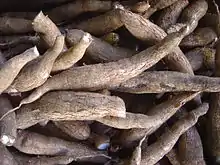Sierra Leonean cuisine
Sierra Leonean cuisine consists of the cooking traditions and practices from Sierra Leone. It follows the traditions of other West African cuisines.
Overview

The most commonly eaten food in Sierra Leone is rice, which is typically served as part of every meal eaten,[1] and is considered so ubiquitous that many Sierra Leoneans consider that a meal is not complete without it.[2] Another popular staple food is cassava, which is pounded to make fufu;[1] the leaves of the cassava are formed into a green stew.[2] Palm oil and peanuts are also widely eaten,[2] and while yams are found in Sierra Leone, they are not a mainstay of the diet as they are in other parts of West Africa.[1] Other staples in the Sierra Leonean diet are bananas, cinnamon, coconut, ginger, okra, plantains and tamarind.
Commonly eaten meats include goats, chickens and beef, and there are also a number of dishes using pork as an added ingredient, for example pig.[3]
Oranges, bananas, papayas, lemons, avocados, guava, watermelons, mangoes, and pineapples are fruits eaten by Sierra Leoneans.[4]
Stews

Stews are a fundamental part of Sierra Leone's cuisine, with cassava leaves having been called the country's national dish.[5] Stew is often served simultaneously with jollof rice, white rice or snacks such as plantain, akara, yam or cassava. Groundnut stew, also called peanut stew or peanut soup, for example, often consists of chicken and vegetables that are flavored with groundnuts, such as peanuts.[6] This is often served to families as a large meal.
Cassava leaves
Cassava leaves are an important cooking ingredient in Sierra Leone and considered the primary staple food.[5] In order to prepare them, the tenderest cassava leaves are washed, then either pounded very finely or bruised with a pestle and mortar, and then finely shredded before cooking. The leaves are added to palaver sauce, which is made using red palm oil, mixed with other ingredients, such as onions, pepper, fish, meat, and vegetables to create a stew. The stew is a favorite among Sierra Leoneans at home and abroad. To give the dish a more exquisite taste, coconut oil is used instead of palm oil.[7]
Ginger beer
Ginger beer is typically a homemade non-alcoholic beverage, made out of pure ginger, and sweetened with sugar to taste. Cloves and lime juice are sometimes added for flavor.[8]
See also
References
- Albala 2011, p. 162.
- LeVert 2007, p. 129.
- Albala 2011, p. 164.
- https://www.peacecorps.gov/educators/resources/cuisine-and-etiquette-sierra-leone/
- Osseo-Asare, Fran (2005), Food Culture in Sub-Saharan Africa, Greenwood Publishing Group, p. 32, ISBN 0-313-32488-3
- "West Africa | Encyclopedia.com". www.encyclopedia.com. Retrieved 2020-05-26.
- Osseo-Asare, Fran (2005), Food Culture in Sub-Saharan Africa, Greenwood Publishing Group, p. 33, ISBN 0-313-32488-3
- Massaquoi, Rachel C.J. (2011). Foods of Sierra Leone and Other West African Countries: A Cookbook. AuthorHouse. p. 152. ISBN 9781449081546.
Cited works
- Albala, Ken (2011). Food Cultures of the World Encyclopedia. 1. ABC-CLIO. ISBN 9780313376269.CS1 maint: ref=harv (link)
- LeVert, Suzanne (2007). Sierra Leone. Marshall Cavendish. ISBN 9780761423348.CS1 maint: ref=harv (link)
External links
| Wikimedia Commons has media related to Cuisine of Sierra Leone. |
